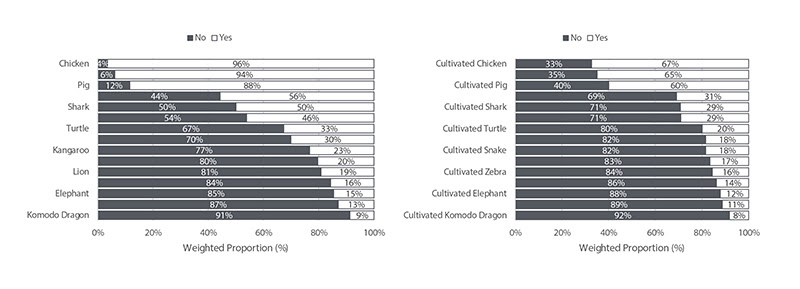
WEST LAFAYETTE — According to the March Consumer Food Insights Report, many consumers view conventional meats as both tastier and healthier than laboratory-grown alternatives.
The survey-based report from Purdue University’s Center for Food Demand Analysis and Sustainability assesses food spending, consumer satisfaction, values, support of agricultural and food policies, and trust in information sources. Purdue experts conducted and evaluated the survey, which included 1,200 consumers across the U.S.
This month’s report explores consumer perceptions of and willingness to try exotic and cultivated meats. It highlights differing responses to queries based on meat type: conventional (noncultivated) or cultivated. The researchers use the term “conventional” meat to describe meat that is sourced conventionally—bred and raised or hunted, slaughtered, and butchered. Cultivated meat is grown or cultivated in a laboratory from animal cells.
Focusing on familiar meats that Americans can find in any grocery store, such as beef and chicken, center researchers saw a big difference between the perceived taste and healthfulness of conventional versus cultivated versions. The traditional versions received a higher average rating in both aspects.

“We see similar results when evaluating consumers’ willingness to try conventional and cultivated meats in a restaurant setting,” said the report’s lead author, Joseph Balagtas, professor of agricultural economics at Purdue and center director. For common meats, such as beef, chicken, and pork, the researchers found that about 90% or more of consumers are willing to try conventional or noncultivated meats.
“The proportion of consumers willing to try the cultivated versions of these meats is around 30 percentage points lower, though it is still a majority, about 60%,” Balagtas said. “Given the fact that cell-cultured meat is not widely available, these results reflect consumer distrust of the unknown when it comes to food, which is a barrier for any novel food trying to break into the market.”

However, among consumers unwilling to try conventional chicken, cow, and pig, around 46%, 26%, and 22% said they are willing to try cultivated versions of these meats, respectively. “This shows that there may be (a) market for cultivated meat among a sizable portion—albeit small number—of consumers who do not eat meat along with a majority of consumers who already are willing to try conventional versions of these meats,” Balagtas said.

The questions about exotic and cultivated meats stemmed from collaborating with Jacob Schmiess, a Purdue Ph.D. student in agricultural economics, who co-authored this month’s report. The results showed that fewer consumers are willing to try exotic meats, though around 50% say they are eager to try professionally prepared octopus, shark, and ostrich.
“Again, we see a willingness to try cultivated versions of these meats drop significantly,” Schmiess said.
The Center for Food Demand Analysis and Sustainability team broke down the results for these and other questions on the March survey by employment status. The researchers compared consumers of working age (ages 18-64) who are working and not and seniors (ages 65-plus) who are working and not. The researchers combined the last 27 months of data (January 2022 to March 2024) for their analysis.
The team has been tracking a sustainable food purchasing (SFP) index every month since 2022 and quarterly since the start of 2024. The index is a self-reported measure of food purchasing designed to assess how well consumer shopping habits align with healthy diets from sustainable food systems based on components from the EAT-Lancet Commission.
The SFP index reveals that retirement-age consumers score higher overall than those of working age, regardless of employment status. “This disparity is driven primarily by the differences in the ‘economic’ and ‘security’ sub-indicators, which measure consumers’ current ability or plans to buy a variety of nutritious and safe foods that fit their budgets,” Balagtas said. “Wealth tends to correlate with age, so finances may be less of a constraint for retirement-age individuals, resulting in higher scores.”
Consumers reported $190 in average weekly total food spending, 2.5% more than in March 2023 and 7.3% more than in March 2022. The consumer estimate of food inflation rose from 6.0% in February to 6.5% in March.
“Similarly, expected food inflation rose to 4%,” said Elijah Bryant, a survey research analyst at the center and co-author of the report. “We continue to see consumer inflation estimates diverge from the consumer price index measure of food inflation, which dropped to 2.2%.
“Recent media attention to food prices may be driving consumer pessimism about food inflation and future food costs, despite the CPI indicating that food inflation is on the decline,” Bryant said. “While prices do continue to rise, they are not quite rising at the high rate perceived by the average American.”



